With corn prices looking a little more bear than bull these days, many no-tillers may be looking for places to trim their input costs. Fair or unfair, the newest management darling of no-tillers — cover crops — may find themselves in the crosshairs.
For most farmers, covers are a somewhat easy target, as there’s a good chance they’re the most recent, and least proven, management practice on the farm. And farmers may have a harder time calculating an exact return on investment with covers vs. other practices.
Before any hasty decisions are made, experts advise that no-tillers give cover crops their fair due.
Stefan Gailans, head of on-farm research for Practical Farmers of Iowa, notes that Iowa State University estimates the cost of crop production each year, including seed, nitrogen and other inputs, and now the group is adding cover crops to that list.
“But instead of seeing it as an added cost, we suggest growers look at it rather as a substitution for other inputs,” Gailans says. “Take a look at if you’re able to cut back on herbicide or fertilizer applications as a result of cover crops.”
He notes that long-term cover-crop users in his network believe they’re doing the right thing for the long-term productivity of their acres by saving topsoil and caching more nutrients in the field’s savings account. But it’s possible that even dedicated cover crop users can trim up programs that they funded aggressively during strong markets, without giving up on them entirely.
Check Your Rate
Cover crops are a developing and ever-changing management practice. That means the seeding recommendations a no-tiller received in 2010 are likely to differ significantly from those given in 2015.
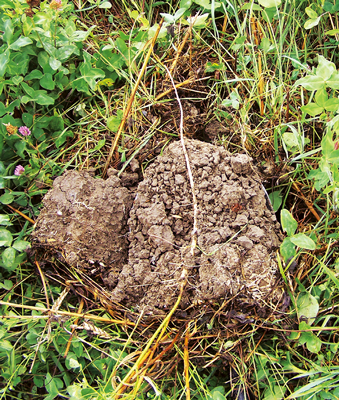
COST OR VALUE. Balancing cover crop cost and return in dollars and cents may be tricky, but those farming in tough soils, like this Ohio clay, know there’s benefit that goes beyond measure.
“In a lot of cases we’ve found that farmers have been overdoing their seeding rates,” says Jim Hoorman, Ohio State University extension educator.
He explains that the old recommendation for radishes used to be seeding them at 8-10 pounds per acre.
“If you put out that many you’ll get a lot of radishes coming up, but they’ll thin themselves and that’s an expensive strategy,” Hoorman says.
Instead, he recommends no-tillers use just 1-2 pounds of radishes in a mix. He cites one farmer using 15 pounds of Austrian winter peas with just 3/4-pound of radish for a total cost of $18-$20 per acre and growing a great crop of corn the following year.
A good source for recommendations is the Midwest Cover Crop Council field guide.
“If you’re trying to save money, go with the lower end of the rates suggested as opposed to the extreme high end of the spectrum,” Hoorman says.
Dave Robison, forage and cover-crops manager for Wisconsin-based Legacy Seeds, agrees that appropriate seeding rates are always good management.
“Overplanting isn’t wise, even when corn was $7 per bushel,” he says.
To cite some common covers, Robison notes it’s important not to cut seeding rates so severely that the goal of the cover crop isn’t achieved. He says 1 bushel of cereal rye per acre is plenty, as is 15-20 pounds of annual ryegrass for getting a good stand that provides weed control, soil protection and building soil organic matter.
“More isn’t better. Two bushels of cereal rye, or 25-30 pounds of annual ryegrass, is overkill,” Robison says.
Consider Seeding Method
The method used for seeding cover crops is another place to do some cost calculations. There are two ways seeding impacts cover crop cost.
For one, how cover crops are seeded impacts what rate is needed.
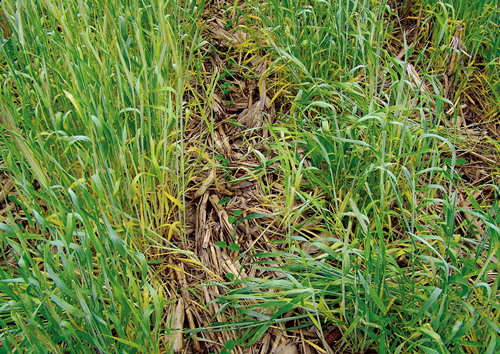
RIGHT RATES. Soybeans emerge among a cereal rye and radish cover crop on Leon Klopfenstein’s farm. Double-checking seeding rates could save farmers using outdated recommendations.
For example, if a no-tiller aerially seeds or otherwise broadcasts annual ryegrass, the seeding rate should be 20-25 pounds of seed per acre, says Ron Althoff, Saddle Butte Ag agronomist. Drilling typically has more accurate seed placement that may result in better germination, requiring less seed.
“Drilling annual ryegrass early in the season, late August through early September, requires a seeding rate of just 9-10 pounds per acre,” Althoff says.
Drilling later, in October, and the rate then bumps to 15 pounds per acre, but that’s still a 5- to 10-pound advantage over broadcast applications. Annual ryegrass is on the less-expensive side, around $0.70 per pound, but the savings still comes out to $3.50-$7 per acre.
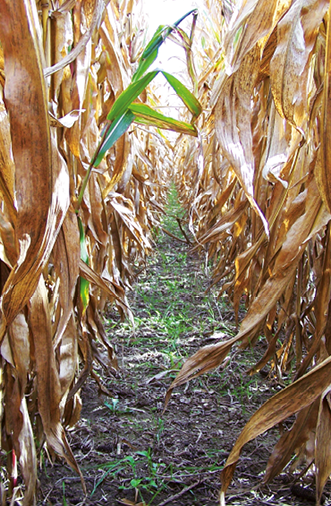
DRILL OR BROADCAST. The accuracy of drilling cover crops as opposed to broadcasting can result in lower seeding rates and a reduction in expenses.
To allow for more time in the fall for drilling and successfully establishing cover crops, no-tillers may want to consider planting crops that they can harvest sooner.
“Breeders have done an excellent job, especially in soybeans, of breeding earlier-season varieties that yield well,” Althoff says. “You can get a great crop with a Group 2 soybean and open up more opportunities for cover crops.”
At seeding, there’s also the expense of the equipment itself. Those paying for aerial broadcasting have the extra expense of a custom application and the burden of the job being done on someone else’s schedule.
Northwest Ohio no-tiller Leon Klopfenstein likes to run a lean operation, including his machinery investments. He plants his crops with a Kinze 612 planter pulled by an 80-horsepower tractor.
So when he wanted to broadcast cover crops into his standing corn, he looked for other options. While he respected the ingenuity of those that converted self-propelled sprayers into cover crop seeders, the price point wasn’t right for his smaller-scale operation.
Instead, he and his son bought a corn detassler and fitted it with a Herd spreader to fling cereal rye seed in a 30-foot swath. For this year, they’ve swapped out the broadcaster with a Vicon spreader mounted on the back of the former detassler that will hopefully spread seed 40 feet.
“It may not be fancy, but it’s not costing me $15 an acre to have someone else broadcast my cereal rye,” Klopfenstein says.
Also worth noting is the extra expense of aerial application.
“If push comes to shove, aerial seeding will be the first thing to go,” says Jack Boyer, a Reinbeck, Iowa, no-tiller. He usually flies on 1 bushel of cereal rye per acre on his acres. Boyer feels cover crops are an essential investment on his farm as the size and harvest methods of seed corn leave little organic matter for his soil.
Mixes and Matches
For those using cover crop mixes, it’s almost become a game of one-upmanship in some areas for who can get the most, and strangest, species planted in their fields.
“A legume might be a little more expensive, but it makes the grass and the radish grow better and is cheaper than buying nitrogen…”— Jim Hoorman
While the synergies and benefits of adding diversity are clear, what’s not clear is how much benefit there is to growing 12 species as opposed to 3 species.
“You start adding a 1 pound of phacelia at $4-6 per pound and you can add a lot of cost per acre really fast,” Robison says. “When the per-acre totals start hitting $40-$50, it’s time to start evaluating whether those expensive little additions are really paying off in benefit.”
High commodity prices provided a great opportunity for growers to experiment with cocktail mixes, he says, but if they don’t feel they’re an outstanding return on investment, paring down the species in a mix makes sense if budgets are tighter.
Getting a Handle on Cover Crop Costs
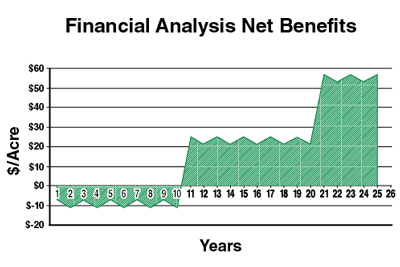
CRUNCHING DATA. Here’s an example from the Cover Crops Economic Decision Tool showing the financial results of a scenario assessing 25 years of incorporating covers into a corn-soybean rotation, where 10 years are required to change soil organic matter by 1%. The display shows the change in operating costs, and negative numbers represent increased operating cost.
As cover crops gain attention and focus, questions are moving from the agronomic to the economic. The NRCS has developed a spreadsheet-based partial budgeting tool to help address some of the economic and financial questions that arise.
This tool is designed to help producers, landowners, planners and others make informed decisions when considering adding cover crops to their production system.
The tool is available for download from the following locations:
- NRCS MO Soil Health Website
- NRCS Illinois eFOTG Section V > Costs and Economic Tools
The tool is built as a partial budget-analysis tool that only captures the costs and benefits that are expected due to a change in the operation.
An instruction page is provided within the tool that should be read so users can understand the inputs required and the results the tool provides.
The agency notes this analysis depends upon user supplied values. Where a user is unsure of the exact variables, they should use the tool to run “what if” scenarios based on different potential ranges on inputs.
Results are presented showing immediate short run net benefits and long run net benefits (up to 50 years). The long-term benefits assess the impact of improved soil health with continued use of cover crops.
“You might get slightly less benefit from a three-way mix, but it’s more affordable,” says Hoorman, who likes a simple mix of one grass, one legume and one brassica.
“A legume might be a little more expensive, but it makes the grass and the radish grow better and is cheaper than buying nitrogen. The most important aspect is having live roots in the ground year round,” he says.
Tweaking mixes to fit in a price range can be a frustrating process, requiring a lot of time on the phone with your seed dealer. But there are options available to help take some of the pain out of that process.
Online cover-crop calculators allow growers to experiment with different species and seeding rates.
One such tool is the SmartMix calculator from Green Cover Seeds out of Bladen, Neb. The online program lets no-tillers input goals, planting dates, geographic location and other variables, and create their own mixes based on those parameters.
Mixes are rated for carbon to nitrogen ratio, nitrogen fixation, grazing suitability, frost tolerance, etc. They can make a mix based on their needs and goals and then manipulate it by adjusting seeding rates and swapping species to create a mix in their budget.
“When creating cover-crop mixes, we base it on percent of full seeding rate,” explains Keith Berns, co-owner of Bladen, Neb.-based Green Cover Seeds. If a full rate of oats is 80 pounds and a producer wants to use 20 pounds in a mix, that’s 25% of a full rate.
“When all of the species in a mix are combined, we want a total seeding rate of 125% for full coverage using that mix,” he says.
He notes that no-tillers can probably cut back to a total of a 100% rate without having too large of an impact on the cover crop performance, but that he wouldn’t go any further.
“Seed sizes in these mixes vary, so you’ll never get all the seeds at the optimum depth,” Hoorman says. “As a result you have to up your seeding rates as you’re losing some efficiency.”
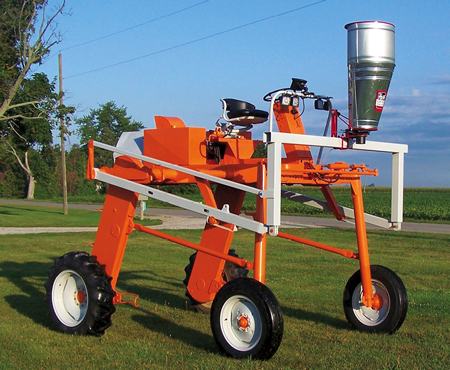
LEAN THINKING. Leon Klopfenstein keeps cover crop seeding cost low with an old detassler fitted with a spreader.
Another workaround, he says, is to select cover crops with similarly sized seeds, such as crimson clover and radishes, with oats as filler. “Those mixes have good success at a low price.”
What no-tillers can do, instead of cutting total seeding rates, is dial in the rates of each species within their budget.
“If you have 20% legumes in a mix, which are often more expensive, you can back that off, but we would encourage you to increase the rate of something else, like oats, to keep from having bare spots, especially if your goal is weed control,” Hoorman says.
He also mentions that while legumes are more expensive, they produce nitrogen, which has a tangible value.
Diverse mixes don’t have to carry a hefty price tag.
One of Berns’ customers in eastern Colorado uses a 13-way mix that runs just over $20 per acre. “It just takes some time to sort through the cover crops and determining what can get the job done in the most cost-effective fashion,” Berns says. “Our calculator takes some of the hassle out of that process.”
It’s also important to choose less risky cover crop species for a no-tiller’s region to help make sure the investment pays off.
“Oilseed radishes get a lot of play all over the country, but in a corn-soybean rotation in Iowa they’re somewhat limited, in my opinion,” Gailans says. “I would go with crops like wheat and cereal rye that germinate in cooler temperatures and overwinter.”
Gailans says members of Practical Farmers of Iowa are researching other brassicas like mustard and rapeseed that are less expensive and may perform better in a corn and soybean rotation.
Tap Funding
A great way to trim cover-crop costs is to make someone else pay for the investment.
Cost shares, such as those available through the Environmental Quality Incentives Program (EQIP) and Conservation Stewardship Program (CSP) can help offset seed and planting costs, while farmers still gain the benefits, including the additional data that’s often collected off those acres.
What’s more, no-tillers in critical watersheds are likely to have access to even more funds. To reduce nutrient loading in the Kankakee and Iroquois rivers from their watersheds, the 2015 Clean Water Indiana grant program has allotted $72,500 to cost share cover crop programs and collect cover crop data in a select area.
The Maryland Agricultural Water Quality Cost-Share Program, funded by the Chesapeake Bay Restoration Fund and the Chesapeake Bay 2010 trust fund, provides grants for both traditional cover crops and those that no-tillers may want to harvest.
Their website notes the cost-share rate in recent years for harvested cover crops was around $25 per acre. Traditional cover crop cost shares ranged from $45 per acre to $100 per acre.
“There are a lot of funds out there for cover crops, especially in watersheds,” Althoff says. It’s well worth the time for no-tillers to investigate funding options in their region.
Another Option: Do Nothing
Some good news for no-tillers wanting to keep the status quo is that prices for cover-crop seed are coming down.
“Almost across the board our prices have dropped 8-10% as compared to 2014,” Berns says.
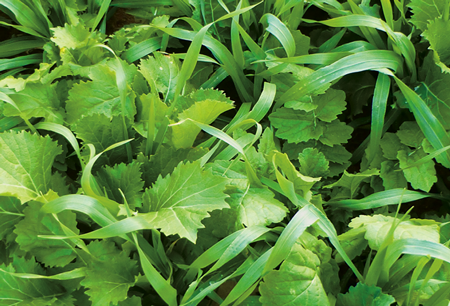
KEEP IT SIMPLE. Proving added value of a 12-way or more mix over a simpler 4-way mix, such as this spring barley-turnip-radish-forage rapeseed mix, is hard. As pressure to be economical with mixes increases, a simple cover crop blend may be the better option.
Althoff reports a similar situation, with annual ryegrass, crimson clover and radishes leading the pack in price drops, though not all crops have decreased in price.
Several factors influenced this price drop, he says.
In the case of crimson clover, supply was short so prices went up, up, up until no-tillers said enough, and planted something else. Seed companies then found themselves with a surplus and the market corrected itself.
A wet year in the Southern states led to fewer acres of annual ryegrass planted, Althoff says, leaving a surplus in that market, too. Cereal rye, however, seems to be staying at about the same price due to popularity.
Berns suspects cover-crop seed prices may sink even lower and more opportunities for planting cover crops may be emerging.
“As commodity prices drop it’s an opportunity for people to look at what else they can grow and break out of the mindset that they can only grow corn and soybeans, which just isn’t true,” Berns says.
More diversity in rotations can result in earlier harvest times opening up more opportunities for planting cover crops. And, more producers may be tempted to commit acres to growing cover-crop seed.
Let It Ride
While these are some ways no-tillers may consider trimming their cover crop programs, many would advise there are smarter places to make cuts on farm inputs.
“It’s pretty well proven across the country that we can plant cereal rye after corn, plant soybeans into it and pick up a 4- to 7-bushel yield advantage in soybeans,” Robison says. He estimates it costs about $25-$35 per acre to seed cereal rye. It only takes about 3 more bushels of soybeans to make up that cost, and that’s not counting any compaction alleviation, erosion savings or benefits to soil health.
“It’s a no brainer,” Robison says.
“More isn’t better. Two bushels of cereal rye or 25-30 pounds of annual ryegrass is overkill…”— Dave Robison
When wheat acres are in play, Robison also classifies a mix of brassicas and legumes as “no brainer” choices.
“A lot of these cover crops earn a 5-10% yield increase. That can also be achieved by buying better genetics, foliar feeding or putting on a little more nitrogen, but those inputs don’t also benefit the soil,” Robison says. “Cover crops are a long-term investment in production.”
While Klopfenstein likes to run a lean operation, he says he doesn’t see cover crops as something he would cut in any way that would sacrifice the benefits he receives.
His flat, heavy clay soils are pretty unforgiving, especially when it comes to managing water, and he’s found no-tilling and cover crops are essential for keeping water from ponding in his fields.
Klopfenstein is several years into his cover crop program and notes that it may be a tough time for someone to get their feet wet in the practice if commodities continue to fall.
“Can I put a pencil to cover crops and say, without a doubt, they’re making me money? No. But on these wet years I haven’t had to replant corn or soybeans, there’s no water sitting in my fields and my biological activity has improved.
“It’s a package deal and I don’t intend to change anything about my cover crop program.
Boyer admits it’s tough to tie a benefit to cover crops in the short-term or on an annual basis, but the long-term benefits have him sticking to his program.
“I’ve been using the Haney soil test that allows you to see organic and inorganic nutrients in the soil. After 3 years of testing fall and spring, my soil health index showed an increase of available nutrients. My soil organic matter has also improved 0.5% from 2010 to 2014,” Boyers says.
“Cutting my program at this point would set me back more than I’m willing take.”

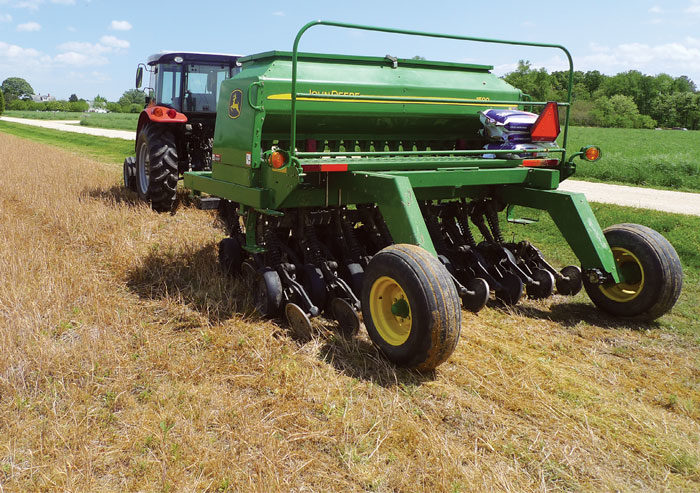






Post a comment
Report Abusive Comment